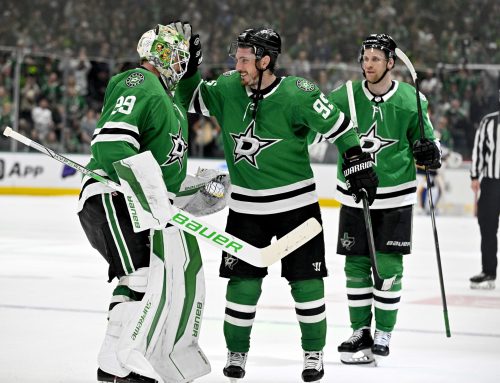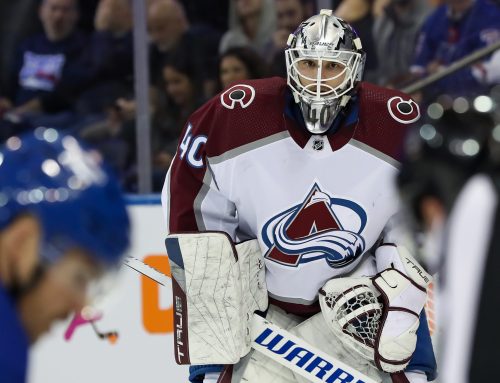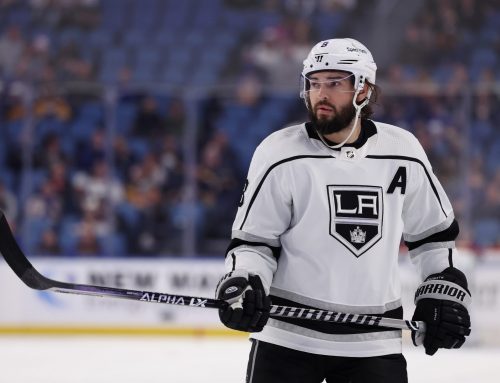Projections, Projections, We All Love Our Projections
Ryan Ma
2009-05-26

Littered in the forums are plenty of questions regarding projections for next season. Does so and so have 65-point upside? Or between these two players who has the higher point potential? For those who have followed my columns in the past year, they would know that I’m a big stats-oriented guy, so this week I’m going to try to rationalize some projections by attaching some numerical values along with them.
First, let's clear up some general misconceptions about projections:
1) Not all players with decent offensive qualities have 80 point potential.
o Only 17 players hit 80 points this past season, and 19 players the year before that, all of which were essentially on their team’s number one top-line, so if you’re projecting for someone that interchanges between second line/top line duties, there is a high chance that they won’t hit 80 points this year.
2) Not all players with decent offensive qualities have point-per-game potential.
o Only 17 players were above the point-per-game mark this past season, and 23 players the year before that. Follow the same guidelines as above when projecting point-per-game numbers.
3) Team depth is vitally important; a player playing on the third line isn’t going to be a candidate for 80 points, or even 60 according to the numbers below.
4) Salary plays a large role in ice-time distribution, generally speaking if a team is forking out six million or higher in salary for a player, they are going to receive optimal ice-time. In the salary cap era of the NHL, teams will be very hard-pressed to stick a player making bucket-loads of cash on a checking line.
o Only exception I can think of is Michael Nylander in Washington.
5) Ice-time plays a huge factor in point production.
o Every forward in the top 50 in scoring garnered over 17 minutes of ice-time. The only exception was David Krejci at 16:51.
o In the top 100, there’s a bit if disparity, but rarely does a player average under 15 minutes of ice-time (three out of 100).
6) The Eastern Conference is the more offensive of the two conferences.
o The Western Conference teams averaged 229.9 goals last season, while the Eastern Conference teams averaged 237.1.
o If you have a comparison between two players in a similar point range, choosing the player in the East Conference might give you a slight point advantage over the Western Conference player.
7) Past history plays a integral part in projections
o For example, Daniel Sedin 71, 84, 74, 82 is fairly consistent, head into next season projecting 78 points and you should be ok.
8) Beware of breakout rookie seasons.
o Six out of the nine rookies last season that hit 35 points or more actually took a hit in their point total from their rookie season to their sophomore season, does anyone believe in the sophomore slump?
9) On a positive note, it appears that the 13-27 point range is where players tend to build on their rookie seasons. 12 out of the 18 players in that range found a rise in their point totals from their rookie season to their sophomore season.
10) Beware of band-aid boys
o Face it at the end of the day, if player X doesn’t play, he won’t get points. If the player is on Dobber’s band-aid boy list, beware of drafting him, or at least acknowledge the fact that he may miss some games due to injury.
o Case in point, Semin might average 1.2 points-per-game played, but if he sits out 20 games due to injury, you’re missing out 24 points. Take that into account when projecting point totals, so that you won’t be disappointed when player X does go down with an injury.
11) Be wary of the “magical fourth year”
o Look at Ryan Getzlaf’s career point totals: 39, 58, 82, 91
o Corey Perry: 25, 44, 54, 72
o Zach Parise: 32, 62, 65, 94
o Ilya Kovalchuk: 51, 67, 87, 98
o Pavel Datsyuk: 35, 51, 68, 87
o Jeff Carter: 42, 37, 53, 84
o Derek Roy: 19, 46, 63, 81
12) Be realistic with your projections, everyone in the league has 100 point potential. It’s whether there’s a one percent chance or an 85 percent chance.
o I can go out on a limb and say Bobby Ryan is going to score 75 points this season. (I’m thinking in my head there’s a 30 percent chance of that happening) or I can bit more conservative and expect Ryan is going to score 60 points this season. (80 percent chance of that happening) If he ends up bombing out and scores 40, I’m only out 20 points as opposed to 35…
Now onto the real mathematical stuff. Keep in mind these are general average numbers, there may be certain exceptions to each scenario.
Centers
– A top 10 point producing center averages 81 games played, along with 29.5 goals, 61.7 assists, 225.2 SOG and 20:30 in ice-time during the season.
– A 60 point producing center averages 76 games played, along with 25.8 goals, 33.6 assists, 217 SOG and 18:31 in ice-time during the season.
– A 50 point producing center averages 76 games played, along with 22 goals, 28 assists, 157 SOG and 17:49 in ice-time during the season.
– A 35 point producing center averages 65 games played, along 11.5 goals, 23.1 assists, 124.5 SOG and 16:45 in ice-time during the season.
Left Wings
– A top 10 point producing left wing averages 78 games played, along with 36.9 goals, 47.9 assists, 265.9 SOG and 19:27 in ice-time during the season.
– A 60 point producing left wing averages 78 games played, along with 28.4 goals, 31.4 assists, 214.8 SOG and 18:10 in ice-time during the season.
– A 50 point producing left wing averages 75 games played, along with 20.8 goals, 29.6 assists, 146 SOG and 16:32 in ice-time during the season.
– A 35* point producing left wing averages 63 games played, along with 16.5 goals, 18 assists, 118.5 SOG and 15:49 in ice-time during the season.
*there wasn’t any players in the 35 point range, so I averaged two 39-pointers and two 33-pointers to get 35-point numbers.
Right Wings
– A top 10 point producing right wing averages 80 games played, along with 30.8 goals, 43.9 assists, 252.7 SOG and 19:22 in ice-time during the season.
– A 60 point producing right wing averages 78 games played, along with 24.8 goals, 34.2 assists, 196.2 SOG and 17:11 in ice-time during the season.
– A 50 point producing right wing averages 77 games played, along with 22.5 goals, 26.3 assists, 185.5 SOG and 17:16 in ice-time during the season.
– A 35 point producing right wing averages 73 games played, along with 15.6 goals, 19.4 assists, 144.2 SOG and 15:10 in ice-time during the season.
Defenseman
– A top 10 point producing defenseman averages 77 games played, along with 16.8 goals, 41.7 assists, 189.7 SOG and 24:40 in ice-time during the season.
– A 40 point producing defenseman averages 73 games played, along with 10 goals, 29.6 assists, 139 SOG and 21:40 in ice-time during the season.
– A 30 point producing defenseman averages 72 games played, along with 6.2 goals, 23.8 assists, 109 SOG and 19:51 in ice-time during the season.
– A 25 point producing defenseman averages 71 games played, along with 4.6 goals, 19.1 assists, 102.1 SOG and 21:15 in ice-time during the season.
Goalies
I didn’t know how to tier the goalies without getting 50 billion complaints about how I did it, so I guess I’ll just state some quick points.
– Only two goalies had 40 or more wins (Mikka Kiprusoff, and Evgeni Nabokov)
o So I really would temper my expectations for wins when projecting wins for goalies.
o Seven had 35 wins or more.
– Only four goalies played 70 games or more. (Kipper, Marty Turco, Niklas Backstrom and Henrik Lundqvist)
– The average top-40 goalie, won 50.7% of their games and started in 50.375 games in a season.
– Only three goalies had a win percentage of 60% or higher along with a minimum of 50 games played. They are Roberto Luongo, Tim Thomas and Nabokov)
– When averaging the 10 goalies closest to the 60 games played mark, you get stats of roughly, 30 wins, 51.4% win percentage, 2.61 GAA, and a .912 save percentage.
o Generally speaking, a 60 starts goalie, is probably a tandem like Tomas Vokoun/Chris Anderson or Martin Biron/Antero Niittymaki.
So you’re probably sitting there wondering, there’s a whole bunch of numbers, what does it all mean? Here’s an example of how I would use the above numbers to help project a player’s point total for next season.
Let’s take a look at Joffrey Lupul’s stats, he played in 79 games last season, while averaging 15:41 in ice-time and had 194 SOG. He’s roughly bouncing around the second and third lines in Philadelphia, and he’s a right wing. If I look at the numbers, a reasonable projection for next season would be around 50 points. If you want to give him the benefit of the doubt, go five more and say 55. If you think someone like Claude Giroux or James VanRiemsdyk will alter his value go five less and say 45. Either way if you give yourself a range of 55-45 you’re alright, if he goes bonkers and fires off 65 you’re a happy camper, if he completely bombs and pots 35, well you really only missed out on 20 points anyways.
Let’s try a second example to make sure we’re all on the same page. Loui Eriksson played in all 82 games last season. He averaged 19:49 in ice-time and fired 178 SOG. His ice-time is amongst the top-10 left wingers in the league, but his SOG totals are almost 100 off. If you compare it to the 50-point left wingers he’s well above them, so we’ll stick him in the middle of the road, 60–point range. Now let’s consider his team, Brendan Morrow is the team’s top left wing, but because of he was injured, that might have been the reason why Eriksson had such a good season. When he returns that might affect the numbers, so we’ll drop ten points. Wait until it’s Eriksson’s “magical fourth year”, add 15 points. So if we end up with a projection of 65 points, everyone is happy. He may have a “magical” year like the monsters mentioned above, and tally 82, or he might not and end up tallying 50. Either way with a projection of 65 points, we’ve covered all our bases.
So hopefully you can use the guidelines above, along with the numbers to help you gain a better grasp of what’s a reasonable projection for player X for next season. Of course if you are desperately seeking different opinions, hop onto the Dobber Forums and there will be plenty of Dobberites who are ready and willing to give you’re their opinions.





 T.B
T.B FLA
FLA NYI
NYI CAR
CAR TOR
TOR VGK
VGK VAN
VAN EDM
EDM MIN
MIN STL
STL
